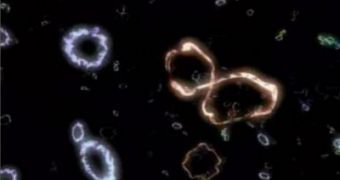They say the string theory is not real science, but merely a science fiction description of the universe. This is mostly due to one thing: the string theory makes predictions than cannot be tested in real life, thus it cannot be proven and is falsifiable. For example, the string theory proposes that elementary particles are not spherical, as suggested in the Standard Model, but they are in fact more like little strings of energy vibrating in the fabric of space-time.
The unique vibration frequency gives each particle its flavor. The problem is that, at the moment, we cannot event prove that particles are not spherical, so how are we going to demonstrate that they are strings of energy or that they are vibrating? Secondly, the string theory suggests that we are living in an eleven-dimensional universe and there may in fact exist parallel universes. Again string theory only proposes the idea of parallel universes, but cannot provide with a mean to actually prove that they exist or how could we establish a link between two such worlds.
The only thing that keeps string theory as a leading contender for the title of Theory of Everything, is its being the only model which has proven that the four fundamental forces in the universe could in fact be unified.
The chance of proving the string theory lies in the cosmic strings. Cosmic strings represent an one-dimensional defect in the fabric of space-time. Such an entity, only 1.5 kilometers in length and measuring less than a proton in diameter, could in fact have a mass comparable to that on the Sun. Researches from the University of Illinois say that we could probe the universe for the existence of cosmic strings by measuring the light absorption in the 21-centimeter spectrum of neutral hydrogen.
If the cosmic strings would be found indeed, then the astronomers could start looking for networks of cosmic strings that would contain an inflating brane, respectively our universe. Rishi Khatri, graduate student at the University of Illinois, says that only 400,000 years after the Big Bang the universe was only a thick shell of hydrogen atoms illuminated by the light we currently observe in the form of the CMB radiation. Furthermore, neutral hydrogen has the capability of absorbing light in the 21 centimeters wavelength, which can be observed in the density distribution map of the CMB.
String theory predicts that the universe may be contained by a network of cosmic strings created soon after the Big Bang. If such structures do exist, than the uniques 21 centimeter wavelength radiation would be altered by the fluctuations in the gas density produced by the presence of the cosmic strings. However, to measure the perturbations created by the presence of cosmic strings in the 21 centimeter wavelength would require a radio telescope with a collective area more than 1,000 square kilometers, which could be made by implying current technological procedures, but it would be prohibited by the time scale of such project and the fact that it would be extremely expensive to build.

 14 DAY TRIAL //
14 DAY TRIAL //